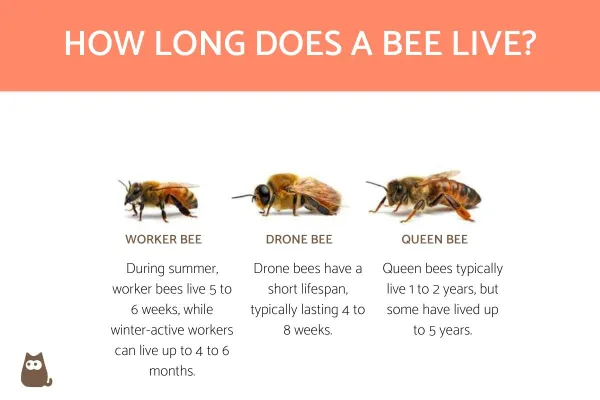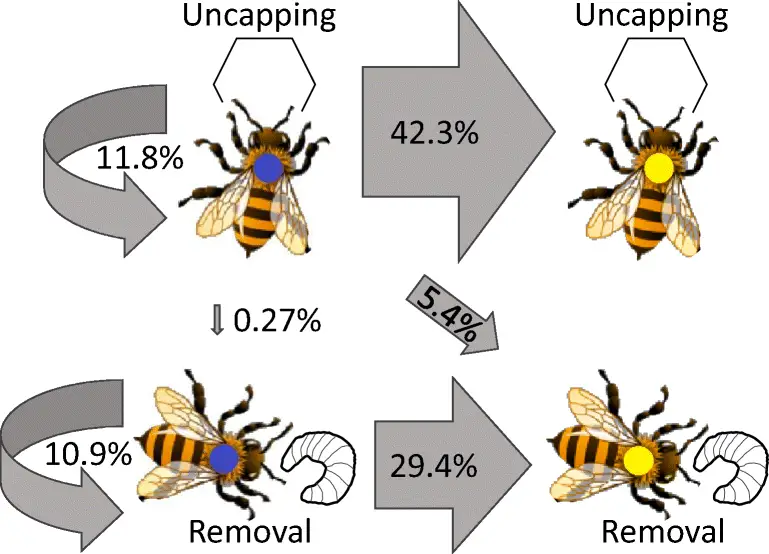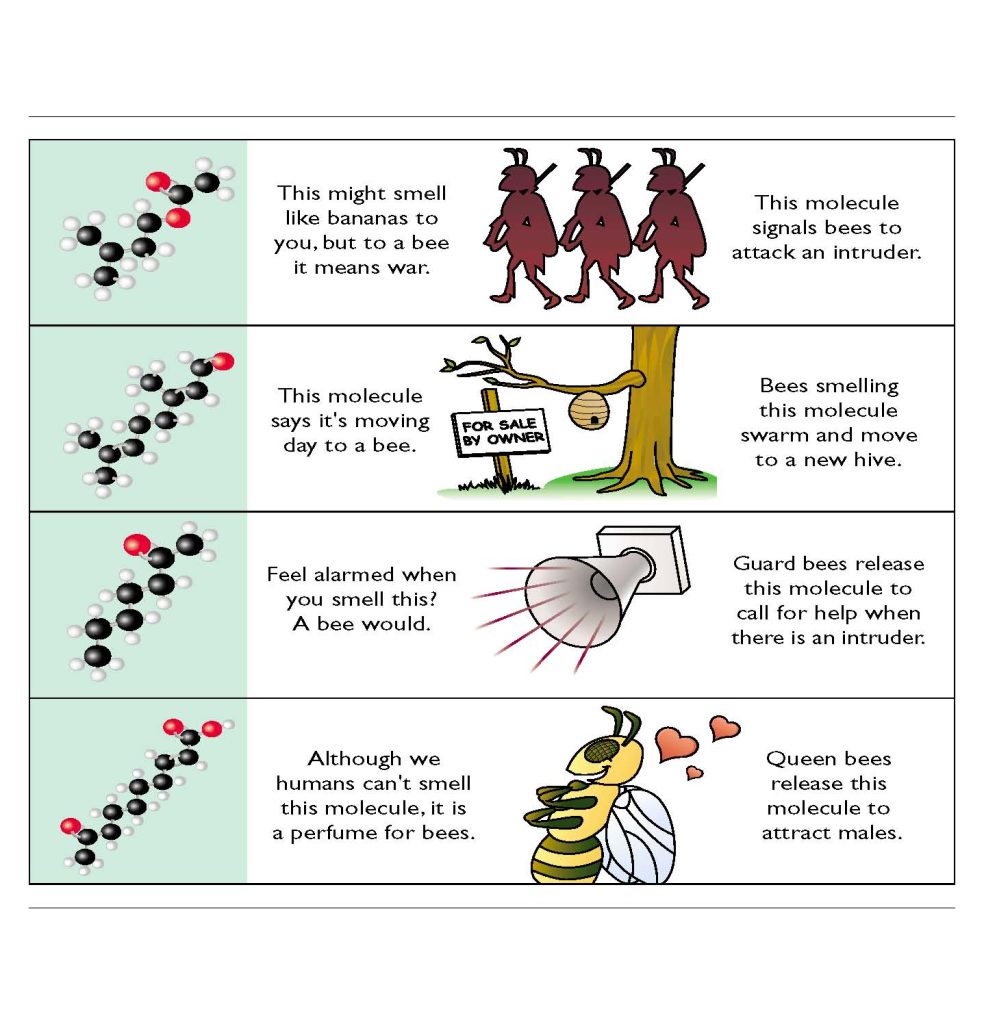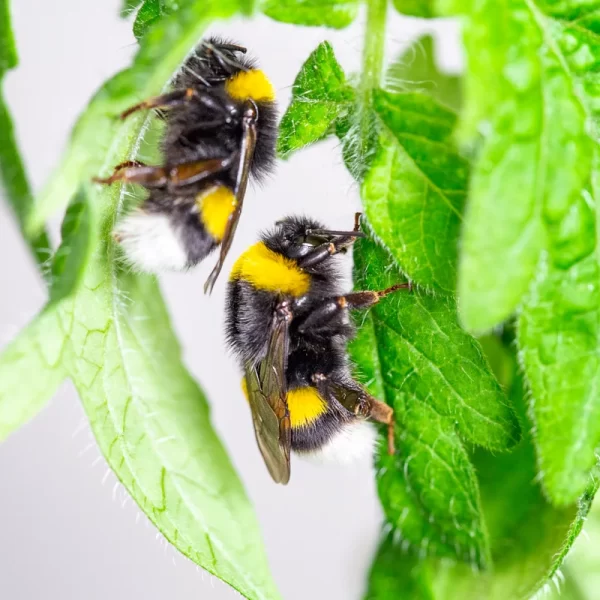Join us today on a journey into the incredibly fascinating realm of the honeybee. A complex and extraordinary animal that intrigues and interests animal lovers. Today we are going to explore 10 different compelling facts about the honeybee’s existence. From their intricate communication methods down to their role in sustaining our natural environment. Each fact will help us understand and appreciate more these industrious insects.
Hive Harmony: Pheromone Communication
Honeybee communication is highly complex and believe it or not, pheromones play a huge part in creating hive harmony. These Pheromones are split into different categories such as the alarm pheromone, nasanov pheromone, brood pheromone, mating pheromone, and queen pheromone.
Pheromones are chemical signals that serve as a language that transcends simple words. Pheromones allow bees to convey complicated information regarding their surroundings such as potential dangers, new honey sources, a fertile queen, or even just simple needs of the hive. This unique type of communication is essential to maintain order in the hive and showcases their ability to navigate their complex social structure.
Dance Navigation: The Waggle Dance
The waggle dance (Cool name right?) Is a mesmerizing dance performed by honey bees and serves as a unique form of communication. When a forager bee finds a source of food, it will return to the hive with news of its findings. And how do they communicate the discovery of their bountiful food source? Well, through the waggle dance obviously. This dance involves figure of 8 pattern, with straight segments that indicate the direction of the food in question. The amazing thing about this dance is the amount of information it can convey. Such as location, distance, and even quality of the food in question.
Lifespan and Roles: How Long Do Honey Bees Live?
The lifespan of a worker bee is around 6 weeks however this can vary depending on the time of the year and the different types of job the bee performs. Bees are delicate animals and a single tear/wear on the wing or body of a bee will significantly decrease their lifespan. It’s said that bees who emerge during the late summer or early fall have a higher chance of living longer as they are needed to help the colony survive in the cold winter months.
Queens bees however can live for many years around 1-2 on average. Their role is to produce eggs and they are fed a special kind of royal jelly for their entire lives which contributes to the quality of their health and reproductive abilities

Bees and the Concept of Zero:
The discovery that bees grasp the concept of zero adds another layer to the surprising numerical abilities of these tiny insects. Trained to pick the smaller of two numbers through a series of picture-based trials, bees consistently chose an empty picture, representing zero, over images with two or three shapes. Despite never encountering the void before, 64% of the time, the bees opted for nothing, showcasing their understanding that zero is less than two or three. This revelation underscores the remarkable cognitive skills of bees, joining the ranks of other animals like parrots and monkeys that also comprehend the abstract concept of “nothing” as a numerical value.

Venomous Sacrifice
When a honey bee stings it faces a fate. The structure of the bee’s stinger prevents it from being pulled after piercing skin without self-amputation. As the bee tries to retract the stinger it unintentionally tears its abdomen leaving behind not only the stinger but also a combination of digestive material, muscles, glands, and a venom sac. This unsettling process creates a gap, at the end of the bee’s abdomen ultimately leading to the bee’s death
Following the injection of its stinger, the honey bee’s assault persists even beyond its demise. The bee possesses a cluster of nerve cells orchestrating the muscles connected to the stinger, sustaining the rhythmic back-and-forth movement of the barbs. This persistent motion propels the stinger deeper into the skin, facilitating the ongoing release of venom into the wound. This process can continue for several minutes which is why it’s important to remove the stinger as soon as possible.

Honey Bees are Hygienic
Picture honey bee colonies as bustling cities with their own cleaning superheroes. These hygienic worker bees, a genetic gift in about 10% of colonies, play detective by detecting and removing dead or sick baby bees from their cells, contributing to colony-wide disease resistance. Beekeepers, savvy enthusiasts, boost this trait by selectively breeding colonies with top-notch hygiene. However, the level of cleanliness varies, akin to how people approach tidiness. In a recent study, researchers tinkered with factors like nectar availability (sweet syrup) and the number of baby bees to see how it affected hygiene. Using a cool technique involving frozen baby bees, they found that colonies exhibited a wide range of cleaning levels just two days after the challenge, shedding light on the dynamic and fascinating world of bee behavior. It’s a bit like giving bee colonies unique cleaning tests and watching them shine, revealing how their neatness depends on factors like syrup abundance and the size of their baby bee population. Just like us, bees have their own distinct way of maintaining order.

Bees and Electric Fields
Bees possess an extraordinary ability to detect subtle electric fields around flowers, distinct for each plant species. These electric fields, originating from the charge difference between the ground and atmosphere, act as unique signatures, attracting pollinators. Using a laser vibrometer, researchers found that when bees approached within 10 centimeters of a flower, the electric field caused their hair to bend, activating neurons and enabling them to “sense” the field. This remarkable electrosensory skill, effective within a limited distance, sheds light on the sophisticated capabilities of these tiny pollinators.

Honey Bee Memory
Honey bees possess remarkable memory abilities that are crucial for survival and foraging efficiency. Their spatial memory enables precise navigation within their hive; evidenced by their use of waggle dance to identify food source locations within the colony. Utilizing associative learning, bees link specific stimuli with rewards in order to optimize foraging strategies. Their short-term memory serves them well when recalling recent flower visits; their amazing long-term memory aids them in remembering hive locations, foraging sites, and potential threats. Bees possess the capacity to adapt and learn from experience, enabling them to modify their behavior over time. Beyond biological significance, an understanding of honey bee memory is also integral for addressing pollination challenges and optimizing agricultural practices.

Honey as a Natural Preservative
Honey, beyond its sweetness, has a fascinating history as a natural preservative. Its unique properties, like low moisture, high sugar, acidity, and enzymes, naturally inhibit microbial growth. Ancient cultures used honey for fermentation and curing meats. Today, honey is a healthier alternative to artificial preservatives, aligning with sustainable practices and consumer preferences. It excels in preserving fruits, vegetables, and meats, offering versatility in the kitchen. Modern artisans combine honey with innovative preservation methods, resulting in unique flavors and textures. Success stories of businesses adopting honey highlight its market appeal for flavorful and sustainably preserved foods.

Thermoregulation in the Hive
Honey bees exhibit amazing thermoregulation behaviors within their hive to ensure optimal conditions for raising brood and colony function. Bees devote up to 40% of their energy reserves towards maintaining an ideal hive temperature between 32degC and 36degC for brood development and division of labor. When temperatures become excessively hot, bees also serve as air conditioners by fanning wings and disseminating water droplets through fanning wings to cool the hive down. Colder temperatures force bees to generate heat through flight muscles and pressing their thorax onto brood cells; clustering occurs naturally as warm temperatures during larval development enhance their learning capabilities, which affect behaviors such as foraging and dancing. Winter clustering allows bee colonies to survive harsh conditions by creating heat peaks to maintain temperatures above 30degC and ensure access to stored honey. Such thermoregulatory strategies strengthen resilience and functionality in honey bee colonies.


